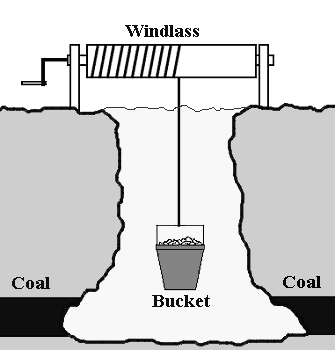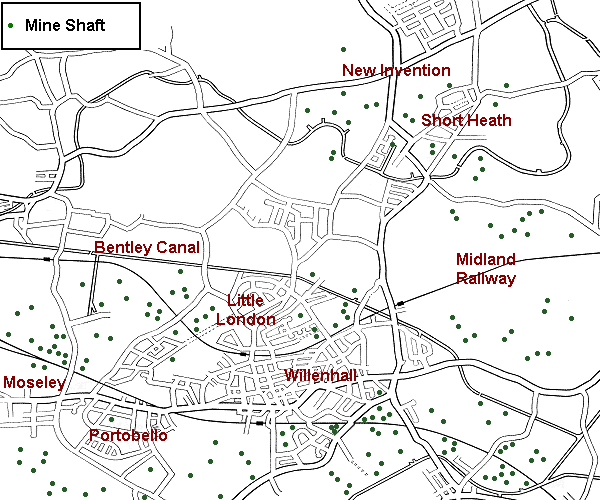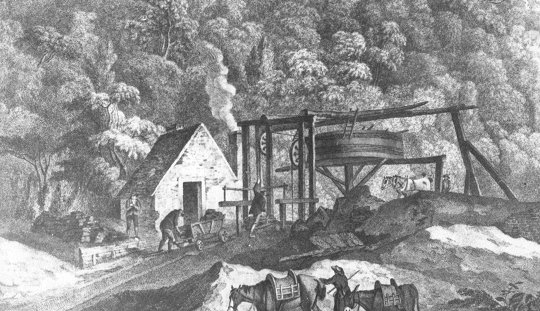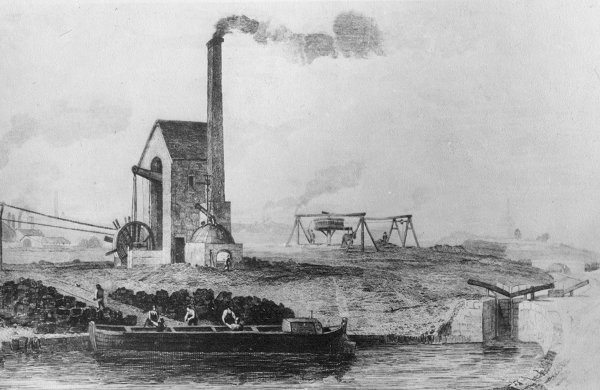|
Coal
Mining
Willenhall stands on part of the
South Staffordshire coalfield, where the middle coal
measures are found, known locally as the ten yard seam.
It forms a gently folded shallow syncline that outcrops
in a wide arc from Dudley through to Darlaston and
Willenhall, and consists of 12 to 14 closely overlying
seams, giving the appearance of a single bed of coal. It
is usually less than 400 feet below the surface, and in
many places can be found just a few feet underground.
The coal measures also extend south
westwards towards Bilston and Wolverhampton, and north
eastwards towards Bentley. The geology on the northern
side towards Wednesfield is quite different. It consists
of a dolerite sill, with mudstones, and sandstones to
the north.
Coal became an essential raw
material for the developing industries in the Black
Country, particularly for iron and steel making, and the
expanding railway network. As a result many parts of the
area were heavily mined, and large numbers of people
moved into the town to work in the mines.
There were a number of deep mines,
which employed many people, often excavating sizeable
caverns underground to fully exploit the 10 yard seem.
Columns of coal were used to support the roof instead of
wooden props, and so many tons of coal must have been
lost in this way. |
|

A typical bell pit. |
Most of the mines were simple bell
pits, in which a central shaft was dug down to the coal
measures, and widened at the bottom as coal was removed.
As much coal as possible was removed until the roof
showed signs of collapse, at which time the pit would be
abandoned, and a new replacement dug nearby.
As a result, much of the mining
land was covered in abandoned bell pits, and in the
course of time consisted of a pattern of hollows,
separated by small spoil heaps. Each hollow was above an
old shaft, which sometimes filled with water, to form a small pool.
Some of the pits, called gin pits,
had horse-driven winding gear at the top of the shaft.
They were a common sight in the Black Country. |
| Pits were dug in much of the land that surrounds the
town centre. Many were to be found around Moseley,
Portobello, Little London, Lane Head, Short Heath, and
New Invention. Portobello grew as a result of the brick
making industry, but soon turned into a thriving mining
community as large numbers of people moved into the
area. It became covered with tiny back-to-back houses,
surrounding courtyards with shared toilets, and washing
facilities. Lane Head and Sandbeds were small hamlets
until they were expanded to cater for the thriving mining
community. |

A map showing the approximate
location of some of the mine shafts in the Willenhall
area. In reality there would have been many more,
because large numbers of small pits were never recorded. |
| Mining in Willenhall got off to a late start
compared with neighbouring towns, because much of the
coal was to be found on land belonging to the Deanery
and the Prebends. In 1811 the Reverend Edward Legge,
Dean of Wolverhampton obtained statutory powers to grant
leases for coal mining on church-owned land. Each of the
small pits, which dominated the area, was run by just a
few men who became known as 'butty colliers', or 'butties'.
Some of the larger collieries were New Priestfield
Colliery, off Bilston Lane, owned by William Ward & Son,
and linked to New Priestfield Iron Works, and the
Birmingham Canal by a tramway. Moseley Hole Colliery,
near Moseley Road, was named after the De Mollesey
family of Bilston, and run by the Chillington Iron
Company. Osier Beds Colliery, near Moseley Road was so
named because of the 'osier' willow trees which covered
the area, and were used for basket making. Beacon Hill
Colliery, which stood near to Beacon Road was owned by
J. Brewer of New Invention, and linked to the Wyrley &
Essington Canal by a tramway, later used by the nearby
Short Heath Colliery.
Others included Bunker’s Hill
Colliery, off Bunkers Hill Lane, Merrill’s Hole
Colliery, Bull Plack Colliery, and Trentham Colliery,
all off Noose Lane, and Willenhall Colliery off Stringes
Lane, owned by Fletcher, Solly & Urwick Limited, which
owned Willenhall Furnaces.
The following is a list of working coal mines in
Willenhall in 1869 and 1870:
|
Colliery |
Owner |
Colliery |
Owner |
|
Albion |
Harper and
Company |
Nimmins |
Dodd and
Southan |
|
Anson |
Earl of
Lichfield |
Noose Lane |
Bate and Son |
|
Barr Croft |
J. Hill and
Company |
Pool Hayes |
Pool Hayes Colliery Co. |
|
Bomans Harbour |
H. B.
Whitehouse |
Pool Hayes |
Samuel
Fenn and family |
|
Boltoney Bay |
J. Yardley and
Company |
Pool Hayes
Meadow |
Chillington
Iron Company |
|
Bull Pleck |
Messrs
Groucott |
Pool Meadow |
Bradley and Robinson |
|
Clothiers |
John Hill and Company |
Portobello |
H. Ward |
|
Coppice |
J. Bagnall and
Sons |
Portobello
Bridge |
Fletcher,
Solly and Urwick |
|
Crescent |
J. Bagnall and
Sons |
New Portobello
Bridge |
Fletcher,
Solly and Urwick |
|
Crescent |
Addenbrook and
Company |
New
Priestfields |
William Ward
and Son |
|
Crescent |
W. Hartshorne and Company |
Robin Hood |
J. Simpkin |
|
Crescent |
Crescent Colliery Company |
Rose Hill |
Chillington
Iron Company |
|
Lane Head |
W. Mannix and
Bate |
Rose Hill |
Brown and
Spittle |
|
Lane Head Bridge |
Joseph Hawkins |
Sand Beds |
Fletcher,
Solly and Urwick |
|
Little London |
Trentham
Colliery Company |
Somerford |
Messrs Barker |
|
Little London |
Solly and Urwick |
Spring Bank |
Springbank Coal Company |
|
Little London |
Mark Gallear and Company |
Tame Mill |
Johnson and
Company |
|
Moat Field |
Dodd and
Southan |
Tame Mill |
Jos. Hincks |
|
Moseley Hole |
Chillington
Iron Co. and Others |
Trentham |
Isiah Hill and
Company |
|
Neachells |
S.
Croucutt & Sons |
Welsh End |
Isiah Hill and
Company |
|
Neachells |
John Sparrow |
Willenhall |
William Ward
and Sons |
|
Neachells Hall |
Barbersfield
Company |
Willenhall |
John Yardley |
|
Neachells |
H. B.
Whitehouse |
Willenhall |
Willenhall Colliery Company |
|
New Neachells |
P. Williams
and Company |
Willenhall |
Thomas Challoner |
|
New Cross |
H. B.
Whitehouse |
Willenhall |
George Hyde |
|
|
|
|
In the 1870s things started to go
wrong. A depression in the iron trade led to a fall in
the price of coal, which in turn led to the closure of
many mines. A long strike took place in the coalfield,
during which all labour was withdrawn. Pumping engines
were not operated, and many mines flooded. In 1870 it was
estimated that around 150 million tons of coal, and 20
million tons of iron ore were under water in South
Staffordshire.
Godson's map of Willenhall,
produced in 1800 shows a pumping engine near to the
junction of Bilston Road and Moseley Road. It is
described as a Crocket and Stokes engine, which would
have been steam driven, and used to pump water from
nearby mines.

A typical gin pit. Courtesy of
David Evans.
Some mine owners would not use a
pumping engine because they were also draining their
neighbour’s pit at their own expense. Pumping also
altered surface drainage, because the water was run into
streams, which percolated back into the mines.
A petition to Parliament led to the
South Staffordshire Drainage Act of 1873. Under the
terms of the act, a Board of Commissioners was created
to raise money to fund pumping operations. A rate of one
penny per ton of coal, slack, and fire clay was levied
on the mine owners, but initially little progress was
made. In 1878 greater powers were granted to the
commissioners. During the next 10 years £100,000 was
spent on pumping water out of the deeper mines. In 1886
the levy was raised to nine pence per ton of coal, slack
and iron ore, three pence per ton of fire clay, with an
addition of one penny per ton for surface drainage.
Water courses were straightened, and made watertight by puddling the beds with clay. In spite of all the efforts,
the drainage problem was never solved, and the
Commission was largely ineffective.

A steam-powered winding engine,
and a gin pit. Courtesy of David Evans.
In 1896 W. Beattie Scott, H.M.
Inspector for the South Staffordshire mining district
compiled a report which listed all of the coal mines in
operation at the time. The mines in Willenhall were as
follows: |
|
Owner |
Colliery |
Underground
Workers |
Surface Workers |
Type of coal |
| A. Lowbridge, Short Heath |
Lanehead Bridge |
5 |
3 |
manufacturing |
| B. Piggott, Bilston Rd, Willenhall |
Mabbs Bank |
15 |
5 |
manufacturing |
| W. Bickley, Short Heath |
Pool Hayes |
104 |
26 |
manufacturing and steam |
| Samuel Habley, Short Heath |
Short Heath (part) |
3 |
2 |
|
| Head & Co. Short Heath |
Short Heath (part) |
6 |
3 |
|
| Joseph Tipper, Spring Bank |
Spring Bank |
2 |
1 |
manufacturing |
| S. Lester, Stringes Lane |
Stringes Lane |
11 |
4 |
manufacturing |
| G. H. Callear, Willenhall |
Trentham |
7 |
2 |
|
| The following list of Willenhall mines, compiled in
1908, is from Ancestry.com. It only includes four
working mines: |
|
Colliery |
Owner |
| Sandbeds (not working) |
T. Nicholls, Fairfield House, Willenhall |
| Bull Pleck |
Southan Brothers, Willenhall Road, Moseley Village |
| Junction |
Southan Brothers, Willenhall Road, Moseley Village |
| Neachells (closed in 1907) |
Southan Brothers, Willenhall Road, Moseley Village |
| Osier Bed |
Samuel Spruce and E. Powell, 10 Victoria Place,
George Street, Ettingshall |
| Rose Hill |
Samuel Weaver, 7 Walsall Road, Willenhall |
| Within a few years it was all over. The Willenhall
mining industry had lasted around 100 years, during
which time large numbers of people had moved into the
area to work in the mines. By 1910 the industry had
become less important. Large amounts of coal were
transported daily on the Wyrley & Essington Canal from
coalfields around Cannock, and also on the Bentley
Canal from coalfields near the BCN. |
 |
|
 |
|
 |
Return to
The Workhouse |
|
Return to
the contents |
|
Proceed to
Local Government |
|